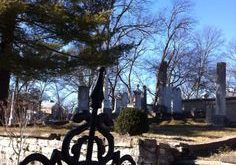Ste. Geneviève Memorial Cemetery
5th & Merchant Streets
Ste. Geneviève, MO 63670
573-883-7544
Open Daily until Dusk
Memorial Cemetery is the final resting place for more than 3,500 people, perhaps up to 5,000. Most grave markers were wooden crosses that have rotted away leaving most graves unmarked. The oldest grave is of Louis Le Clere and is dated 1796. The newest interment, or reinterment, is dated 15 years after the cemetery was officially closed in 1882.
Dr. Lewis Linn was first buried in1843 in Memorial Cemetery, but he did not rest in peace. Because the cemetery had become quite weedy and overgrown, the “model senator” was moved nearby to the new Valle Springs Cemetery. After Memorial Cemetery was cleaned up, in 1938 Senator Linn was buried for the third time. His almost 100-year-old corpse was remarkably preserved in his air-tight, lead-lined coffin, and people lined up to view his face through the window in the lid.
Another burial after the official closure of the cemetery was for Odile Vallé. She wished to be buried with her prominent husband, Felix Valle. In exchange, she donated land for the new cemetery and an enormous sum for the construction of the new brick Catholic Church.
Other notables buried in the cemetery include John Scott, Missouri’s last territorial representative and first Congressman; Jean Baptiste Vallé, the last French commandant of the area; Jacques Misse, an American Revolutionary War soldier; and a Civil War colonel killed at the Battle of Shiloh.
The oldest part of the cemetery is the middle third. This section was for Catholics. As other faiths came to the territory, another section was added uphill. This is where victims of a steamship explosion are buried, as are Native Americans. Some African slaves are buried there as well, while others lay at peace in their enslaver’s plot.
When it became apparent that more room was needed, another parcel was added downhill from the original. Finally, Memorial Cemetery reached capacity and became a health hazard. Burials after May of 1882 were in the new Vallé Spring Cemetery for Catholics, the Lutheran Cemetery, and Crestlawn Cemetery for others.



